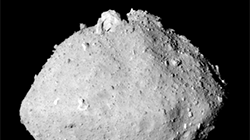We may finally know why spinning-top asteroid Ryugu has such a weird shape
The asteroid has an unusual amount of organic matter on its surface.

Scientists may have finally solved the mysterious origins of the diamond-shaped asteroid Ryugu: It may be the remnants of a long-dead comet.
The new origin theory, taken from findings from Japan's Hayabusa2 mission, suggests that the 0.5-mile-wide (0.8 kilometer) asteroid is actually the rocky remains of a dead comet that, after losing its ice, was smooshed together by its own gravity.
The new suggestion could explain a set of unusual observations from Hayabusa2. The spacecraft, which launched in 2014 and rendezvoused with Ryugu in 2018, spent a year surveying the asteroid's rocky surface before returning to Earth in 2020. That data, when combined with remote observations, yielded a few findings: Ryugu is made up of many small rocks rather than being one large boulder, it was deformed into the shape of a spinning top from rapid rotation and it is made of an unusually large amount of organic matter, or matter rich in carbon.
Related: Why are asteroids and comets such weird shapes?
This abundance of organic matter challenges the dominant theory that Ryugu was born from the collision of two larger asteroids.
Organic matter — the chemical compounds containing carbon-hydrogen bonds essential for life — is typically not found on asteroids, but it is found inside comets. This is because comets form on the outer, colder regions of the solar system, where clouds of organic matter mix with rocks and ice to create these dirty snowballs. Heat from the sun slowly melts new comets, which wander into the inner solar system (bordered by the asteroid belt between Mars and Jupiter). This melting causes the ice to escape the comet in a trail that resembles a long tail.
It is this melting process that created Ryugu — a remnant of gravity-compacted rocks and organic matter left behind after the ice had been vaporized.
Sign up for the Live Science daily newsletter now
Get the world’s most fascinating discoveries delivered straight to your inbox.
Study first author Hitoshi Miura, an associate professor of material science at Nagoya City University in Japan, said this melting process may have caused "the nucleus of the comet to lose mass and shrink, which increases its speed of rotation." This rapid spinning may have given the dead comet's heart "the rotational speed required for the formation of a spinning-top shape," Miura said in a statement.
To further investigate their theory, the researchers built a simple model and used it to calculate the time it would take for a once-icy Ryugu to melt and for its rotational speed to subsequently increase. The model concluded that Ryugu had likely spent a few tens of thousands of years as a comet before it moved into the inner asteroid belt, where it melted and turned into a rubble-pile asteroid.
The researchers need more evidence to know if they're right, but that evidence might be coming soon. NASA's OSIRIS-REx, a van-sized spacecraft, collected a rock sample from another diamond-shaped asteroid, Bennu. When it returns to Earth in 2023, signs of organic matter in the sample could lend credence to the theory that spinning-top-shaped asteroids were once comets and give scientists important insight into the evolution of the solar system.
The researchers published their findings Jan. 31 in The Astrophysical Journal Letters.
Originally published on Live Science.

Ben Turner is a U.K. based staff writer at Live Science. He covers physics and astronomy, among other topics like tech and climate change. He graduated from University College London with a degree in particle physics before training as a journalist. When he's not writing, Ben enjoys reading literature, playing the guitar and embarrassing himself with chess.










